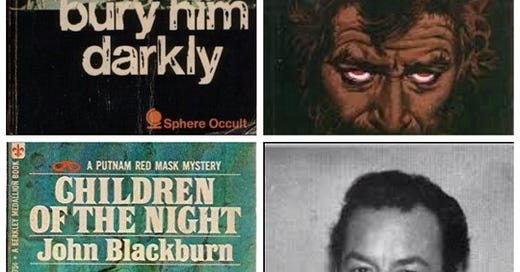Today most horror writers write horror, and most other writers do not.
Few authors now include horror elements -- supernatural or otherwise -- in their fiction. David Morrell and Lee Child, primarily writers of mainstream thrillers, come to mind as exceptions. Child’s 2015 novel Make Me is an excellent example of -- among many other things – non-supernatural or “affect horror,” to use John Clute's term. The UK novelist John Blackburn was another.
For several decades, Blackburn has been off the radar. Thanks to Valancourt Books, his sui generis thrillers have come back to us from oblivion.
Blackburn's style and authorial voice have much in common with two other UK thriller writers: Gavin Lyle and Desmond Bagley. Like them, he began as a working journalist. Unlike them, Blackburn never forsook depicting essentially English characters who combined the characteristics of professional smarts with martinet eccentricity, which provides for strange and often beguiling effects.
Many Blackburn novels commence as protagonists start puzzling over their small corner of an occulted crisis or puzzle. Sometimes the issue arises in another country (The Scent of New-Mown Hay), sometimes closer to home (Bury Him Darkly).
Blackburn typically employs a breathtaking and very confident economy that borders on the perfunctory. (Personally, he has successfully waylaid and misdirected me in the first 100 pages of every novel). While this skill -- the ability to wrong-foot a reader -- is arresting, it is double-edged. How many genre readers today have the curiosity and the confidence in an unfamiliar writer to go all the way?
Master anthologist Hugh Lamb writes on Blackburn in The Penguin Encyclopedia of Horror and the Supernatural (1986):
Blackburn’s first book, A Scent of New Mown Hay (1958), tells of the dreadful results of mutating fungus and introduces one of his stock characters, General Kirk of British intelligence. The novel was an instant success, and since then Blackburn has produced twenty-seven more. For while in the early 1960s he stuck to straight thrillers, but he returned to horror with a vengeance with Children of the Night (1966). This book recounts the strange happenings in a northeastern British town that presage the end of the world (the year of publication had more than usual significance). The final discovery is among the author’s more inspired creations, and the climax ranks among his best.
No slave to fashion, Blackburn followed this with The Flame and the Wind (1967), a historical novel detailing events after the Crucifixion. In 1969 he produced one of his four finest books, Bury Him Darkly. Like so many of his plots, this one deals with ancient evil loosed on the world through greed or stupidity. An eighteenth-century mystic takes his secrets and works of art to the tomb with him. A twentieth-century band of enthusiasts raids the tomb and unleash a horror that causes the British army to flee in panic.
In 1972 Blackburn published two others from this set of four masterworks. Devil Daddy has a plot skillfully woven around the legend of the Wandering Jew; For Fear of Little Men recounts the revival of a pagan cult and its followers’ efforts to exterminate humanity. The fourth and probably best book of this set is Our Lady of Pain (1974), a tour de force version of the legend of Elizabeth Bathory, beautifully entwined with the legend of the evil eye. The ending is the grimmest in all Blackbum's books.
….Blackburn’s speciality is taking old legends and half-truths and weaving them with an ingenious plot into minor masterpieces of horror. He is certainly the best British novelist in his field and deserves the widest recognition.
Some of my own notes on Blackburn’s novels can be found here, here, and here.
Jay
26 June 2023



